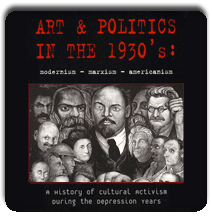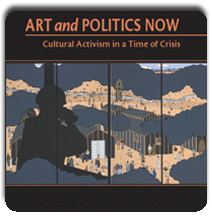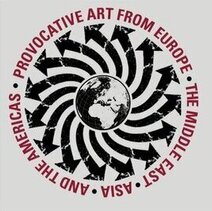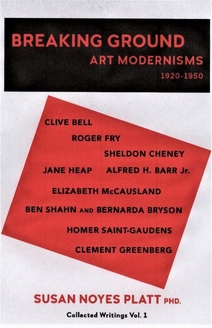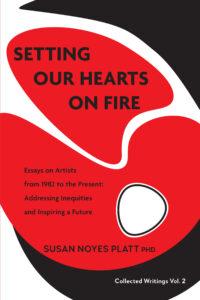Suchitra Mattai She walked in reverse and found their songs
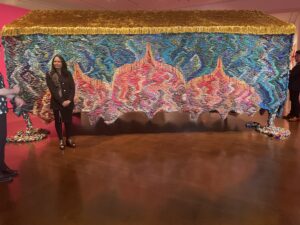 Suchitra Mattai: She walked in reverse and found their songs
Suchitra Mattai: She walked in reverse and found their songs
Asian Art Museum to July 20
![]()
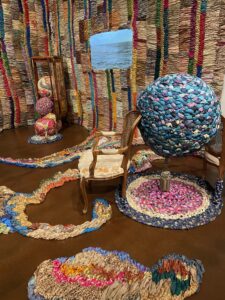
Suchiitra Mattai was born in Guyana (on the North Coast of South America, bordering on Venezuela and Brazil). Her family moved to Canada when she was four, but she has vivid memories of her life there. Her artwork is about recovering and healing the wrongs suffered by her ancestors and telling new stories. The title of her show “ She walked in reverse and found songs” refers to the process of being in the present while thinking about the past.

As we enter her exhibition at the Asian Art Museum we first see a small house structure with red pointed domes as decoration. Suchitra explained that she was invoking Indian Palace architecture. Called “Pappys House” she is creating a type of structure that she imagines her grandparents might have lived in, with her own interpretation added to the exterior. It is more than decorative, it elevates her ancestors to royalty.
In the early 19th century, when the African slave trade was declared illegal, many South Asians were brought to Guyana as “indentured servants” (in reality they were enslaved.) Massai imagines recovering their stories as she undercuts colonial realities.
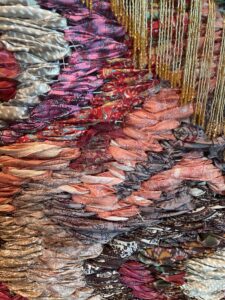
All of her work is made from the torn up saris of laboring women, that are then woven. She also practices needlework and embroidery taught by her forbearers. All these media are an homage to her ancestors and all the indentured slaves who came from South Asia.
In the large installation “memory palace” she carefully placed five pieces of colonial furniture. Each one is covered with large balls made of braided and woven saris that render the furniture useless as well as amusing.
In one chair she has placed a Victorian antimacassar on the seat. Antimacassars were placed on the back of chairs to protect them from hair oil. Putting it on the seat is obviously a joke. This chair also has a large South Asian processional umbrella stuck in the back which can’t serve its purpose of providing shade.
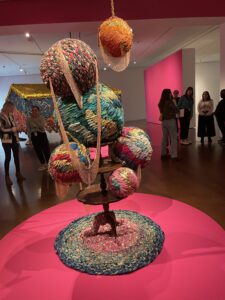
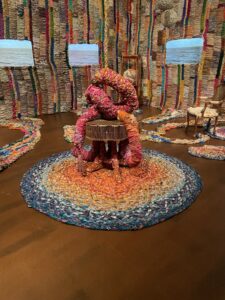
The large woven balls seem as though we might want to pick them up, they pour out of one piece of furniture or balance between two chairs, but they are much bigger than the size of a beach ball and much heavier Fat snake like forms weave over and under another table ornamented with gold tassels. Woven pieces crawl around on the floor.

The larger theme of this room is memories of migration and colonialism: three video screens show the sea moving by as though from a ship.
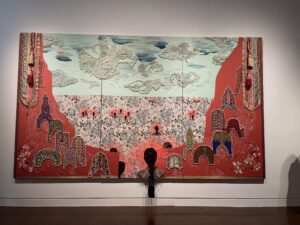
Individual works, also made of woven saris such as “the sea wall,” tell other stories. Apparently Guyana had a sea wall that blocked all view of the sea for workers: Massai has broken it down and imagines workers escaping.
Another surprise is “a self portrait” with its dried grass cape hung across the middle and a colonial medal at its center. Perhaps she is speaking of her own relationship to colonialism.
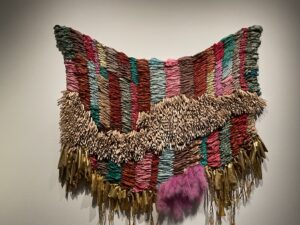 “A Rich Life Lived” has a similar format but the central cape motif is constructed of clothespins. The artist honors domestic labor and rewrites the colonial narrative to honor workers.
“A Rich Life Lived” has a similar format but the central cape motif is constructed of clothespins. The artist honors domestic labor and rewrites the colonial narrative to honor workers.
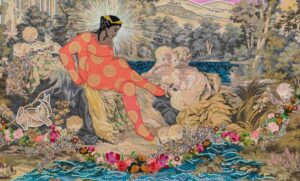
Surprisingly, the title work of the exhibition “she walked in reverse and found their stories” is based on an entirely different starting point: a found 18th century tapestry on which the artist has highlighted a goddess wearing a sari tupe pattern. Many of the details of the tapestry are highlighted with beads and fake gems.
The theme of the exhibition thus takes it point of departure from the idea of a “goddess” wearing a sari pattern , her head sending out rays like a halo from a golden crown, being waited on by European-based putti: what a mixture of references!
Massai speaks of “creating a new mythology and a new way of thinking.” Her provocative works easily speak to us of disrupted narratives, opening the way to create new stories.
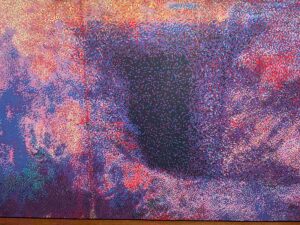
Ai Weiwei
While you are at the Asian Art Museum be sure to spend time viewing Ai Weiwei’s recreation of Monet’s “Water Lillies.” It is created with 650,000 Lego and spans fifty feet (Monet’s is built from six foot panels). Inserted into the waterlilies is the dark cave (square) that invokes Ai Weiwei’s childhood experience shut in a cave for many years because his father was expelled to the desert of Western China for “rightism.” We can sense Ai Weiwei’s claustrophobia. The stunning lego surface seduces us, although it is much more fiery than Monet’s calm blue greens.
This entry was posted on May 17, 2025 and is filed under art criticism, Contemporary Asian American Art, Uncategorized.


